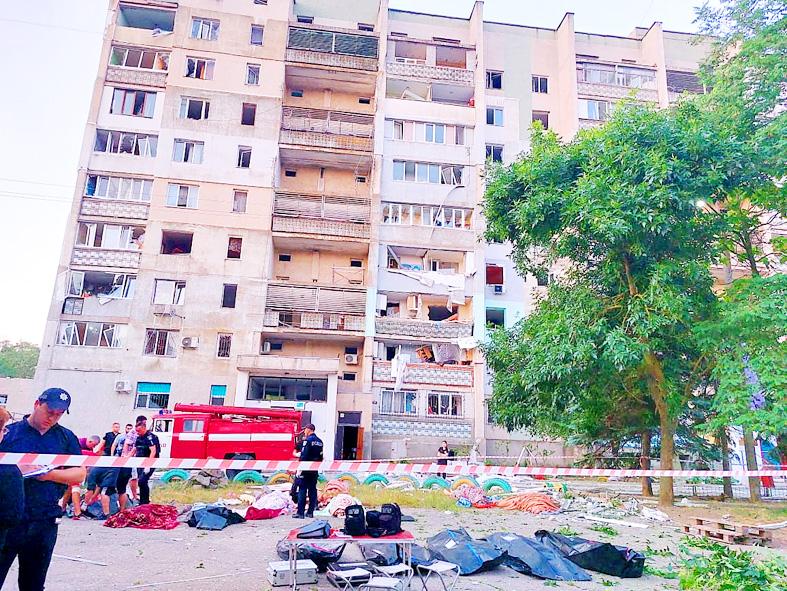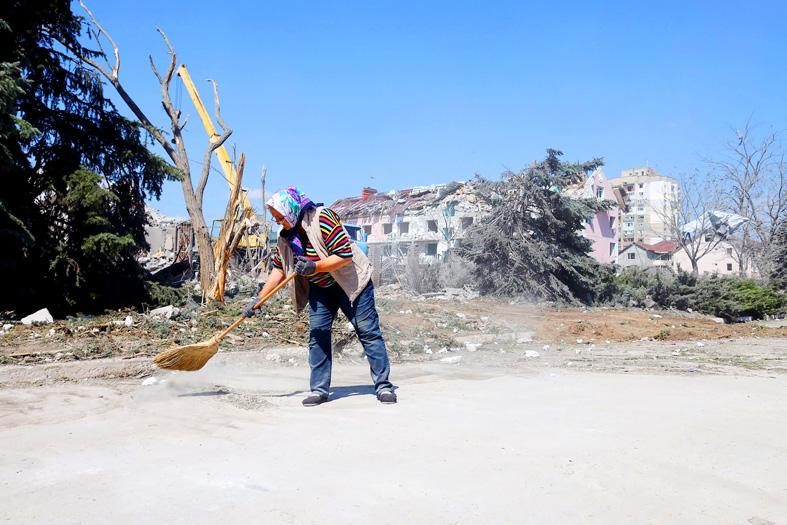Missile strikes yesterday killed 19 people and wounded dozens in Ukraine’s Odessa region, a day after Russian troops abandoned positions on a strategic island in a major setback to the Kremlin’s invasion.
Two children were among the dead and six among the injured, Ukrainian officials said, one day after US President Joe Biden announced US$800 million in new weapons for Kyiv at a NATO summit.
The missiles slammed into an apartment building and a recreation center in the town of Serhiivka about 80km south of the Black Sea port of Odessa, which has become a strategic flash point in the conflict.

Photo: Reuters
“The death toll is 19 people,” Ukrainian State Emergency Service head Serhiy Kruk wrote on Facebook, adding that 38 people were wounded.
The strikes were launched by aircraft that flew in from the Black Sea, Odessa Regional State Administration spokesman Serhiy Bratchuk said.
“The worst-case scenario played out, and two strategic aircraft came to the Odessa region,” he said in a TV interview, adding they had fired “very heavy and very powerful” missiles.

Photo: AFP
There was no immediate comment from Russia on the strikes, which followed global outrage earlier this week when a strike destroyed a shopping center in Kremenchuk, Ukraine, killing at least 18 civilians.
Russian President Vladimir Putin has denied Moscow’s forces were responsible.
“The cruel manner in which the Russian aggressor takes the deaths of civilians in its stride and is again speaking of collateral damages is inhuman and cynical,” German government spokesman Steffen Hebestreit said.
“The Russian population too must finally face up to this truth,” he added.
Ukrainian President Volodymyr Zelenskiy yesterday hailed a “new” chapter of “history” with the EU, after Brussels on Thursday last week granted Ukraine “candidate status” in Kyiv’s push to join the 27-member bloc, even if membership is likely years away.
“We’re not close. Now we are together,” he told Ukraine’s parliament.
“We made a journey of 115 days to candidate status and our journey to membership shouldn’t take decades. We should make it down this road quickly,” he said.
One day earlier he announced Ukraine had begun exporting electricity to the EU, via Romania, as fears grow of an energy crisis in Europe due to reduced Russian gas deliveries.
European Commission President Ursula von der Leyen told Ukrainian lawmakers yesterday that membership was “within reach,” but urged them to make anti-corruption reforms.

LONG FLIGHT: The jets would be flown by US pilots, with Taiwanese copilots in the two-seat F-16D variant to help familiarize them with the aircraft, the source said The US is expected to fly 10 Lockheed Martin F-16C/D Block 70/72 jets to Taiwan over the coming months to fulfill a long-awaited order of 66 aircraft, a defense official said yesterday. Word that the first batch of the jets would be delivered soon was welcome news to Taiwan, which has become concerned about delays in the delivery of US arms amid rising military tensions with China. Speaking on condition of anonymity, the official said the initial tranche of the nation’s F-16s are rolling off assembly lines in the US and would be flown under their own power to Taiwan by way

OBJECTS AT SEA: Satellites with synthetic-aperture radar could aid in the detection of small Chinese boats attempting to illegally enter Taiwan, the space agency head said Taiwan aims to send the nation’s first low Earth orbit (LEO) satellite into space in 2027, while the first Formosat-8 and Formosat-9 spacecraft are to be launched in October and 2028 respectively, the National Science and Technology Council said yesterday. The council laid out its space development plan in a report reviewed by members of the legislature’s Education and Culture Committee. Six LEO satellites would be produced in the initial phase, with the first one, the B5G-1A, scheduled to be launched in 2027, the council said in the report. Regarding the second satellite, the B5G-1B, the government plans to work with private contractors

MISSION: The Indo-Pacific region is ‘the priority theater,’ where the task of deterrence extends across the entire region, including Taiwan, the US Pacific Fleet commander said The US Navy’s “mission of deterrence” in the Indo-Pacific theater applies to Taiwan, Pacific Fleet Commander Admiral Stephen Koehler told the South China Sea Conference on Tuesday. The conference, organized by the Center for Strategic and International Studies (CSIS), is an international platform for senior officials and experts from countries with security interests in the region. “The Pacific Fleet’s mission is to deter aggression across the Western Pacific, together with our allies and partners, and to prevail in combat if necessary, Koehler said in the event’s keynote speech. “That mission of deterrence applies regionwide — including the South China Sea and Taiwan,” he

‘NARWHAL’: The indigenous submarine completed its harbor acceptance test recently and is now under heavy guard as it undergoes tests in open waters, a source said The Hai Kun (海鯤), the nation’s first indigenous defense submarine, yesterday began sea trials, sailing out of the Port of Kaohsiung, a military source said. Also known as the “Narwhal,” the vessel departed from CSBC Corp, Taiwan’s (台灣國際造船) shipyard at about 8am, where it had been docked. More than 10 technicians and military personnel were on deck, with several others standing atop the sail. After recently completing its harbor acceptance test, the vessel has started a series of sea-based trials, including tests of its propulsion and navigational systems, while partially surfaced, the source said. The Hai Kun underwent tests in the port from